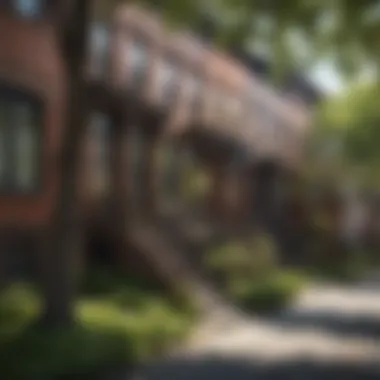Your Guide to Buying a Brownstone in Brooklyn


Intro
Buying a brownstone in Brooklyn isn’t just a financial transaction; it’s a leap into a lifestyle steeped in history and charm. Brownstones stand as testaments to architectural excellence, offering a unique glimpse into the past while offering the potential for contemporary living. As urban hubs like Brooklyn continue to rise in popularity, understanding the nuances of this distinctive housing option becomes essential.
From the quaint allure of tree-lined streets to the vibrant heart of local culture, a brownstone encapsulates all that Brooklyn has to offer. For potential homeowners, especially those captivated by real estate, the charm of these homes can be intoxicating. Yet, the path to ownership is often riddled with challenges—market trends shift like quicksand, neighborhoods evolve, and hidden costs can lurk around every corner.
This guide sets out to equip you with the insights needed to cut through the noise, making informed decisions as you embark on this journey. Whether you’re a first-time buyer or a seasoned investor, understanding what a brownstone represents can be the difference between a dream home and a costly mistake.
Armed with thorough knowledge of architectural styles, design trends, and local dynamics, you can navigate the purchase process with confidence, transforming what can be a daunting task into an enjoyable endeavor.
Let’s dive into the crux of purchasing your very own brownstone, exploring every essential aspect along the way.
Understanding Brownstones
When embarking on the journey to purchase a brownstone, it is crucial to grasp the essence of what these historic structures represent. Brownstones are not just buildings; they embody a unique blend of architectural elegance and cultural heritage that speaks to the vibrant history of Brooklyn. They are often seen as a gateway to embracing urban life while still enjoying the comfort of a well-established home.
Brownstones typically feature rich, red-brown sandstone facades, intricate moldings, and remarkable stoops, offering a character that modern constructions rarely replicate. Understanding brownstones is about appreciating their aesthetic appeal and acknowledging their significance in shaping community identity.
Prospective buyers will discover that brownstones often come with a narrative—each has its own story, influenced by the people who have lived within its walls and the neighborhoods that have thrived around it. These elements can affect resale value and local community engagement, making it essential to study them closely.
Through keen insight into these buildings, you can weigh the benefits and challenges that come with ownership. Brownstones typically have spacious layouts that promote communal living, but they may also necessitate higher maintenance costs and renovation efforts. Grasping these details provides an informed foundation for potential buyers, ensuring they make choices that can benefit their lifestyle and financial goals in the long run.
The Historical Significance of Brownstones
The historical significance of brownstones cannot be overstated. Emerging in the mid-19th century, they quickly became the hallmark of middle-class urban living. The design was a response to the city's booming population, showcasing elegance within a practical framework. Prominent architects like Richard Upjohn contributed to the early designs that became the envy of emerging neighborhoods.
Owning a brownstone is akin to possessing a piece of history—structures often bear witness to significant events and societal shifts. As areas gentrified, these homes transformed from affordable housing to coveted real estate, often reflecting the economic tides of Brooklyn.
In essence, the past of brownstones enriches their present value, providing a narrative that could very well captivate future generations.
Brownstone vs. Other Styles
Understanding the distinctions between brownstones and other types of residences is essential for any buyer.
Comparative Architectural Features
Brownstones exhibit specific architectural features that set them apart from other styles, such as row houses or multi-family units. Their signature brownstone facades are not just visually appealing; they symbolize resilience, standing the test of time against New York's relentless climate and urban development. These properties usually offer high ceilings, grand staircases, and detailed cornices that contribute to a sense of spaciousness and luxury.
One key characteristic of a brownstone is its deep-set parlor floor, often featuring large windows that create inviting light-filled spaces. This contrasts sharply with more modern styles, which may prioritize function over flair, losing some of the historical provenance that appeals to discerning buyers seeking authenticity.
However, while these features are endearing, they may also come with drawbacks, such as outdated systems that require updating during renovations.
Neighborhood Context and Impact
The neighborhood surrounding a brownstone significantly adds to its appeal. Often, brownstones are found nestled within culturally rich enclaves, giving residents easy access to local charm—think quaint coffee shops, art galleries, and vibrant parks.
What separates these neighborhoods from others is their sense of community. Living in a brownstone usually means participating in a tight-knit environment where neighbors know each other by name. This adds a layer of intimacy to urban living not widely found in newer developments.
Yet, the neighborhood impact isn’t always rosy. As areas gentrify, original residents might feel pushed out and rising costs could strain those who have called the area home for years. Therefore, understanding the neighborhood dynamics should be at the forefront of any potential brownstone purchase.
The Brooklyn Housing Market
Understanding the Brooklyn housing market is crucial for anyone considering the purchase of a brownstone. This vibrant sector is not just about properties; it's a reflection of a community's culture, economic trends, and the allure of urban living. Given its historical allure, unique architectural features, and diverse neighborhoods, the market possesses characteristics that are essential for prospective buyers to comprehend.
Navigating this market means understanding how supply interacts with demand, the implications of rising prices, and the nuances of local neighborhoods. Knowledge in these areas equips buyers to make informed decisions, ultimately ensuring a more satisfying buying experience.
Current Trends in Real Estate
Market Data Overview
In today's market, the data tells a compelling story. The Brooklyn housing market has witnessed a surge in interest, especially in neighborhoods that exhibit a rich history paired with new developments. Real estate prices are on the rise, reflecting a shift from suburban attractions to urban conveniences.
This trend reveals a key characteristic: increasing demand for brownstones, particularly among those who value both aesthetics and community. The unique feature of this uptick in demand is the blend of gentrification and the intrinsic charm of Brooklyn's brownstone architecture, making it a favorable choice for those looking to buy. However, the disadvantage is the potential for overpaying if one acts too hastily without fully understanding the market's cyclical nature.
Impact of Gentrification
Gentrification significantly shapes the landscape of Brooklyn, with both positive and negative impacts. It often brings improved amenities and infrastructure, which can enhance property values. Yet, it also leads to displacement of long-term residents and shifts in community dynamics.
A key characteristic of this shift is the influx of businesses catering to higher-income residents, which sometimes alienates existing community members. Understanding this aspect is vital for buyers considering brownstones, as it informs them about both the potential for property appreciation and the sociocultural landscape of the neighborhood. The unique feature here is the dual nature of gentrification: while it may provide investment opportunities, it also comes at the cost of community cohesion, an essential consideration for any potential buyer.


Pricing Dynamics
Factors Influencing Prices
The pricing of brownstones in Brooklyn is not static; various factors can influence it dramatically. Proximity to public transportation, the quality of local schools, and the vibrancy of neighboring businesses all play roles in shaping real estate prices.
A beneficial choice for buyers is to focus on neighborhoods in the early stages of development. These areas often present significant price appreciation potential, making them attractive investment opportunities. However, a disadvantage is the risk involved – if growth stalls or reverses, buyers may find themselves with a less valuable asset.
Cost of Ownership Analysis
Analyzing the cost of ownership is essential when purchasing a brownstone. Beyond the purchase price, potential buyers must consider factors like property taxes, maintenance, utilities, and possible renovation costs.
A key characteristic of this analysis is the long-term financial commitment associated with owning a Brooklyn brownstone. It can be a beneficial approach to see these costs not just as burdens but as necessary investments that can yield significant returns in both value and living enjoyment. Conversely, unique features of brownstone ownership include the charm and character of the home, which may require ongoing investment to maintain but ultimately contributes to its allure and market value.
"The Brooklyn brownstone is not just a home; it�’s a piece of history that tells a story of architectural elegance and community resilience."
Understanding these elements is crucial for discerning buyers. The Brooklyn housing market, with its blend of history, gentrification, and ever-evolving pricing dynamics, poses both opportunities and challenges, making informed decision-making essential.
Key Considerations in Buying a Brownstone
When it comes to buying a brownstone in Brooklyn, several key considerations must take center stage. The charm and character of these historic homes often draw buyers in, but understanding the nuances of ownership is critical. This section serves as a guide to help prospective owners navigate through significant aspects like location and the condition of the property, ultimately providing clarity in a complex transaction.
Location and Neighborhood Assessment
Evaluating Convenience
Evaluating convenience is more than just a quick glance at a map. It encompasses access to public transportation, shopping hubs, and recreational outlets. A brownstone sitting near a subway station can be a game-changer for daily commuters. Think about it: a home that saves you precious minutes can make life a lot less hectic.
One key characteristic of evaluating convenience is proximity to essential services such as grocery stores, healthcare facilities, and schools. For many families, having quality educational institutions within walking distance can be a huge plus. The unique feature here is the ease of lifestyle—having a strong neighborhood infrastructure allows residents to feel settled and engaged without always having to venture too far.
However, not every convenient location comes without its downsides. Higher foot traffic and noise levels in busy areas might be a trade-off for that convenience. So, while conveniences abound, balance is essential—find an area that suits both your lifestyle needs and personal peace.
Exploring Community Features
When considering community features, it’s like peeling an onion—layers of local culture, shared spaces, and neighborhood events come alive. The community vibe often enhances the appeal of a brownstone. Vibrant local cafes, farmer’s markets, and parks can imbue a sense of belonging that is key to enjoying residential life.
A notable characteristic of exploring community features is the presence of like-minded individuals and groups. Art collectives, neighborhood watch programs, or even informal book clubs can cultivate a supportive network that enhances day-to-day life. A unique aspect to consider, however, is how community features can shift the longer you're in a neighborhood. They can morph dramatically due to development or changing demographics, so it’s wise to ask residents about ongoing changes.
Yet, communities aren't just about fun and gatherings; they also play a crucial role in property values. A neighborhood that hosts annual street fairs or art walks can see appreciating property values, while a dormant locale might not yield the same return on investment.
Brownstone Condition and Inspections
Understanding Structural Integrity
While the Victorian facade of a brownstone may charm buyers instantly, understanding its structural integrity is paramount. It’s essential to ensure that key components, such as foundations and roofs, are sound. A brownstone’s historical nature might mean that it requires more maintenance than a newly constructed home, highlighting the importance of thorough inspections.
The key feature of examining structural integrity lies in preventing unexpected costs down the line. Problems with the roof or plumbing can lead to significant headaches and financial burdens after purchase. On the flip side, fully understanding these aspects can lend you leverage in negotiations with the seller. Knowing the current condition of key systems gives you confidence in assessing fair pricing, ensuring you do not overpay for needed repairs.
However, unless you have an eye for detail, engaging a seasoned inspector might prove invaluable. This will help uncover issues that a layperson might miss, thus safeguarding your investment.
Identifying Potential Issues
Identifying potential issues extends from structural concerns to outmoded wiring and outdated plumbing systems. Think about this; finding a brownstone with potential problems, like mold or foundation cracks, can turn your investment from a dream sanctuary into a costly undertaking.
One prominent characteristic of identifying these issues is the benefit of a preemptive approach. A detailed examination before buying can save you from waking up one day to extensive repair bills. The unique aspect to focus here is the provision of transparency—obtaining this knowledge not only impacts your purchasing decision but can also foster trust with your agent and the current property owners.
Yet, weigh the energy you’re ready to invest into renovations against the useful life left in the structure. Some might relish rescuing an old gem, while others may prefer a move-in-ready situation. Furthermore, articulating these findings in your offer can present a well-rounded negotiation strategy, promoting an educated request for price adjustments or repairs to be made by the seller before finalization.
Closure
Assuring a solid understanding of location advantages and property conditions ensures both immediate satisfaction and long-term value. A brownstone is not just a place to live; it’s an investment in lifestyle and heritage. By considering these key factors, prospective buyers can equip themselves with valuable insights into making astute purchases in Brooklyn's dynamic real estate market.
Renovation Potential and Planning
Renovating a brownstone is not just about enhancing aesthetics; it's a strategic choice that can significantly increase property value and improve living conditions. As you embark on your brownstone-buying journey, understanding renovation potential is crucial. The original architectural elements of a brownstone often tell a story of the past, but with the right planning, you can blend the charm of yesteryear with contemporary functionality. This delicate balance plays a pivotal role in the overall satisfaction found in such a purchase.
Assessing Renovation Opportunities
When considering the renovation of a brownstone, several key elements come into play.
Maximizing Space Efficiency


Maximizing space efficiency refers to the smart utilization of available square footage. Brownstones typically come with both magnificent potential and some spatial challenges, especially in older homes with smaller rooms. The beauty of maximizing space lies in its ability to transform the home without needing to expand physically. For example, consider replacing traditional bulky furniture with minimalist, dual-purpose pieces. This simple switch can create a room that feels airy and inviting—perfect for urban living.
A standout feature of maximizing space is the clever integration of storage solutions. Built-in shelving or under-stair storage can dramatically reduce clutter while showcasing the unique characteristics of your brownstone.
- Advantages:
- Increases perceived space
- Maintains aesthetic appeal
- Enhances property value
However, the downside might include costs related to custom cabinetry or professional design services. But, in an environment where every square foot counts, these investments usually pay off in livability and resale value.
Restoration vs. Modernization
The choice between restoration and modernization is a matter of personal style and financial pragmatism. Restoration leans towards preserving historical elements, such as crown moldings or original tile work, while modernization brings in fresh ideas like open floor plans and cutting-edge fixtures. This dilemma is crucial as it can influence not only the home’s character but also its market appeal in Brooklyn.
Restoration is beneficial in retaining the classic charm that brownstones are known for. By highlighting those distinctive features, you keep the intrinsic value intact. Picture maintaining intricate woodwork or vintage fireplaces as a centerpiece of your living room—each element would echo a piece of Brooklyn's diverse history.
- Advantages:
- Enhances historical value
- Creates a unique living experience
On the flip side, modernization can make the home more appealing to a broader audience, especially younger buyers who seek practicality. Think sleek designs, energy-efficient appliances, and smart-home features. The risk? You might lose some of the brownstone’s character in the process. Thus, a balanced approach often yields the best outcome, allowing you to savor history while embracing modern conveniences.
Permits and Regulations
Navigating permits and regulations is an essential step in any renovation journey. Many new homebuyers may find themselves overwhelmed by the intricacies of local guidelines, but familiarizing yourself with these rules enhances the overall renovation process.
Navigating Local Guidelines
Understanding local guidelines involves diving into the specifics of what is allowed and what is not when it comes to home renovation. Each neighborhood in Brooklyn has its design restrictions and zoning laws. Knowing what you can and cannot build or alter is paramount.
- Key characteristic: Comprehensive local guidelines offer protection against potential legal issues.
- Advantages:
- Ensures your renovation meets legal standards
- Helps avoid costly fines or setbacks
For example, if you’re looking to replace the original windows, you might need to adhere to guidelines that dictate the type of materials and styles that are historically appropriate. Failing to follow these might lead to a denial of permits and unexpected delays. It's beneficial to consult with local experts or reach out to the building department to gain clarity on what to expect during the renovation process.
Understanding Zoning Laws
Zoning laws provide the framework for how properties in a neighborhood can be used. This aspect is crucial when planning renovations, especially if you're considering modifications that could alter the building's use.
- Key characteristic: Zoning regulations dictate what structures can be built on a property and how they can be used.
- Advantages:
- Protects neighborhood cohesion
- Can enhance future property value
For instance, converting a brownstone into multifamily units may be possible if zoning laws permit it. However, if that’s restricted, you might have limitations on how you can utilize your property to its fullest potential. Researching away ahead of time will save you headaches down the road.
In the wild world of Brooklyn real estate, knowing your renovation potential and planning thoroughly can help you seamlessly blend the vibrant historical essence with modern living practices. This careful planning does not just add to living experience but often points towards greater appreciation when the time comes to sell.
The Buying Process
The journey to acquiring a brownstone in Brooklyn is not just about finding a charming facade or a cozy interior. It's a multifaceted process that demands careful navigation through various stages - from initial research to closing the sale. Understanding the buying process is crucial for any prospective owner because it lays the groundwork for making informed, strategic decisions in a competitive market. This section will delve into the elements that shape the buying experience, ensuring a smoother transition into homeownership.
Finding the Right Agent
Choosing a real estate agent can make or break your brownstone buying experience. An experienced agent not only understands the nuances of the Brooklyn market but also helps bridge the gap between you and the complicated maze of home purchasing.
Evaluating Experience and Expertise
When searching for an agent, one must consider their experience and expertise as a key factor. An agent who has been in the game for a while often possesses a deeper understanding of local trends and property values. The key characteristic here is familiarity—knowing the ins and outs of the various Brooklyn neighborhoods can give you an upper hand in negotiations. A seasoned agent often has a strong network, giving you access to off-market listings and insights that new agents might not have. So, if you want someone who has seen it all, checking their track record can be beneficial.
On the flip side, a less experienced agent might be eager and have fresh ideas but could lack the necessary connection and knowledge, potentially leading to missed opportunities.
Understanding Fee Structures
Next, understanding fee structures plays a significant role in the buying process. Real estate commissions are often a mystery to first-time buyers, and diving into the fine print is crucial. In Brooklyn, agent commissions can range widely, typically around 5% to 6% of the home price. Knowing how agents structure their fees allows you to budget effectively and avoid unexpected surprises.
The unique feature of commission structures is that they can be negotiated. This means that if you’re savvy, you could end up saving on the total cost. That’s a potential advantage if you plan to put those savings toward renovations or closing costs. However, low commission offers can also attract agents who might not have the best connection to potential sellers.


Making an Offer
Once you've found a property that feels like home, you’ll need to master the art of making an offer. This is where knowledge of the market and strategic thinking come into play, ensuring you submit a proposal that stands out in a sea of bids.
Crafting Competitive Proposals
An essential part of the buying process, crafting a competitive proposal is more than just throwing numbers on a page. It requires a careful assessment of the property and understanding comparable sales in the area. The key here is detail—presenting a strong offer often involves attaching a personalized letter to your proposal, highlighting your appreciation for the brownstone’s character and your vision for the future. This unique feature can create an emotional connection with sellers, making your offer memorable. Competitive offers can often set you apart in a hot market, but if not strategized properly, you might end up overpaying.
Negotiation Strategies
Then comes negotiation strategies, which can significantly impact the final sale price. Effective negotiation doesn’t just mean battling it out over the price; it involves knowing when to flex and when to stand firm. The essence of negotiation lies in understanding the seller's motivations��—whether they need to sell quickly or are set on getting the highest dollar. A good agent will guide you through this dance, helping you uncover the seller's priorities and aligning your offer accordingly. This aspect is beneficial as it translates not just to monetary savings but can also lead to a smoother relationship with the sellers.
Closing the Deal
After navigating offers and negotiations, the final step is closing the deal. This phase is where everything culminates into ownership and, as such, requires careful attention to financial and legal matters to seal the deal successfully.
Finalizing Financials
Finalizing financials is about ensuring all money matters line up. This includes ensuring your mortgage is approved, sorting out closing costs, and dealing with any last-minute financial tweaks. It’s a pivotal moment; securing the right financing can make all the difference. The key characteristic here is diligence—reviewing everything from loan terms to interest rates can often save buyers from future headaches. If any inconsistency arises at this stage, it can lead to delays or even fall-throughs in the purchase, which is a disadvantage no new homeowner wants.
Legal Considerations
Last but not least, understand the legal considerations involved in buying a brownstone. This includes title searches, insurance, and all the necessary document transactions. Engaging a real estate attorney can be invaluable here. The significant characteristic of these considerations is that they protect you as a buyer, ensuring you’re not inheriting any hidden liabilities from previous owners. Neglecting this aspect can have severe consequences down the line, potentially leading to disputes or unanticipated costs.
Long-term Considerations
Purchasing a brownstone in Brooklyn goes beyond simply choosing a lovely property. It's a long-term commitment that can shape your lifestyle and investment future. Many buyers think of immediate factors like the price or aesthetic appeal, but long-term considerations are where the real game is played. A brownstone can serve as a sturdy financial asset, contributing to your portfolio while providing a unique living experience. Therefore, understanding these elements is crucial for anyone considering this journey.
Investment Aspect of Brownstones
Market Appreciation Potential
Market appreciation potential plays a pivotal role when weighing the decision to invest in a brownstone. In neighborhoods like Park Slope or Bedford-Stuyvesant, historical data often shows increasing property values over time. Because of that, many see it as a safe bet for long-term investment. The appreciation often stems from various factors including location, desirable amenities, and overall community development.
A notable characteristic of this appreciation is how it often mirrors the ongoing trends of Brooklyn’s cultural and economic landscapes. For instance, as new businesses crop up and the area's reputation for vibrant arts and dining gets strong, property values tend to rise. It's this dynamic nature that makes the market appreciation potential particularly potent for owners. However, one has to be cautious; while some properties soar in value, others might lag behind, especially if they are in less desirable locales or not maintained well.
Rental Opportunities
Another gem in the realm of long-term considerations is rental opportunities. Buying a brownstone grants the flexibility of potentially renting out space for extra income. In Brooklyn, where housing demand is consistently high, turning a brownstone into a duplex or triplex can yield financial returns that complement your living experience.
This aspect of owning a brownstone is especially appealing because it offers immediate financial relief on mortgage payments, allowing you to recoup some of your investment while living comfortably. Furthermore, the unique features of a brownstone—like architectural charm and spacious layouts—often attract tenants, which could mean less hassle in filling your units. Still, potential pitfalls exist; being a landlord requires effort, whether it's dealing with tenants or maintaining the property. It’s essential to weigh these challenges against the benefits to decide if this route aligns with your goals.
Living in a Brownstone
Lifestyle Benefits
Moving into a brownstone isn't just about real estate, it's about lifestyle. Living in one often infuses daily life with a sense of historic charm and belonging. These homes are usually nestled in vibrant neighborhoods filled with character and community spirit.
What makes brownstones especially desirable is their designed spaces. They often feature open layouts that allow for seamless living and entertaining. This can translate into fostering connections among family members or guests. Plus, there's often a close-knit neighborhood vibe that comes with living in historic settings, providing avenues for social engagement and community involvement. However, it’s important to remember that older homes might also require some sacrifices, like maintenance and renovations, which can be demanding for some.
Community and Cultural Engagement
Engaging with the community is another aspect where brownstone living truly shines. Many brownstone neighborhoods are cultural hubs, rich with art, music, and diverse cuisine. This means living here can provide opportunities for ongoing experiences that feed your interests and passions. From local artisan markets to vibrant street festivals, there's rarely a dull moment.
One of the most notable features of this engagement is access to various local networks, whether for socializing or professional development. Such connections can lead to a sense of belonging and community involvement. However, it’s worthwhile to note that these neighborhoods can sometimes become overcrowded, especially as new developments pop up, leading to a shift in community dynamics that may not always be favorable.
"Purchasing a brownstone is more than a financial decision; it's a gateway to a lifestyle enriched by history, community, and future potential."
Overall, the long-term considerations around owning a brownstone in Brooklyn paint a picture that’s rich in potential yet layered with responsibilities. Whether viewing it through an investment lens or as a lifestyle enhancement, understanding these dynamics helps in making an informed decision.
Closure
Purchasing a brownstone in Brooklyn isn't just about making a real estate investment; it’s about buying into a lifestyle, a community, and a piece of history. In this article, we’ve traversed the intricate landscape of brownstone ownership, from understanding the architectural nuances to navigating the often turbulent waters of the Brooklyn housing market. Each section has built upon the last, weaving a rich tapestry of insights designed for prospective buyers.
Reflecting on the Journey
Synthesizing Insights
As we synthesize the insights gained throughout this exploration, it becomes clear that knowledge is power in the realm of real estate. An understanding of market trends, renovations, and neighborhood vibes collectively arms potential buyers with the ability to make informed decisions. It's not merely about numbers; it’s about feeling at home. This focus on comprehensive awareness serves as a critical characteristic of our discussion, emphasizing the multifaceted nature of purchasing a brownstone.
A unique feature of this synthesis is its approach to combining practical advice with personal stories; after all, each brownstone has a tale of its own. This makes navigating the purchase less daunting and more enriched. While there are advantages—like a clearer path through this complex process—there’s also the potential disadvantage of overwhelming complexity. After all, the more you know, the more questions you might have. But tackling those questions head-on is part of the journey.
Next Steps for Prospective Buyers
For prospective buyers, understanding the next steps post-article becomes crucial. This aspect connects the dots between knowledge acquired and action taken. Whether it’s engaging with a local agent or considering neighborhood pros and cons, the knowledge gained here leads to better choices in the home-buying landscape. This step-by-step approach is a beneficial choice that ensures potential buyers don't feel lost in the myriad options available.
A noteworthy unique feature of navigating “next steps” is that it transforms theoretical understanding into practical application. However, this transition may introduce its uncertainties and challenges, such as financial considerations or personal preferences. The essence lies in proactive engagement with available resources—be it financial advisors or local community forums—like those found on platforms such as reddit.com or through local groups on facebook.com. Like any journey, having a map can help you find your way amid a city of endless possibilities.







